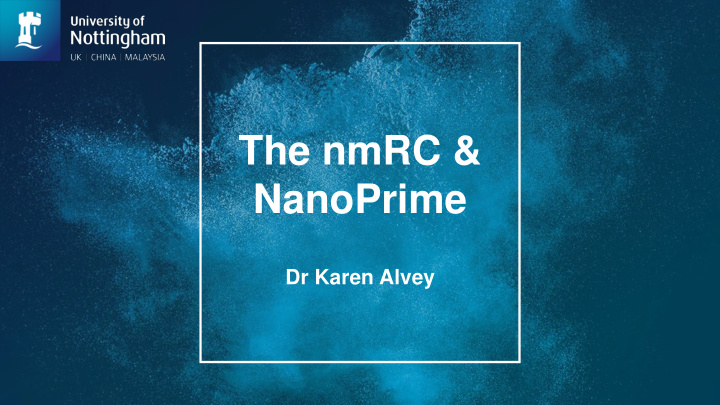



The nmRC & NanoPrime Dr Karen Alvey
Overview The nmRC Research capabilities NanoPrime
The nmRC facility Opened in April 2016 Enabling and enhancing micro/nano scale materials science research Cripps South Building (53)
The nmRC facility Mass spec imaging (2018) ToF-SIMS with OrbiTrap “Globally unique”
Research capabilities • Field emission SEM allows high resolution imaging at the • Field emission TEM allows high resolution imaging at the nanoscale. nanoscale. • Cryogenic capabilities allow the investigation of hydrated • Cryogenic capabilities allow the investigation of hydrated material, ideally suited to life science applications. material, ideally suited to life science applications. • Detectors for EDS, WDS, EBSD and CL capture elemental and • Detectors for EDS, EELS, RHEED and HAADF capture structural information. elemental and structural information. • Focused ion beam allows site specific sectioning of material at • In situ materials testing (variable temperature, electrical the microscale. conductivity). • In situ materials testing (tensile stress, variable temperature, • Tomography stage for 3D image reconstruction. variable humidity).
Research capabilities • Quantitative elemental composition • Confocal depth profiling • • Empirical formula derivation • Four excitation wavelengths available: 325, 532, 660 & 785 nm • Depth profiling • SWIFT and DuoScan mapping options for fast mapping applications • Chemical state identification, electronic state binding energies and densities • In situ flow through cell. • Elemental mapping ( XPS imaging ) • Variable temperature stage (-196 to 450 ºC). • Cryogenic analysis • Choice of gratings for standard or high resolution spectroscopy • Bespoke functionality for the analysis of ionic liquids
Research capabilities New developments: • Sputtering nanofabrication system. • Electron beam lithography and cleanrooms. • OrbiSIMS (arriving 2018) with suite of cryogenic preparation equipment.
Instrumentation Details of instruments are in welcome packs and will be available on the NanoPrime website
Expertise Technique Instruments Contact details JEOL 6400 SEM Martin Roe FEI XL30 SEM martin.roe@nottingham.ac.uk JEOL 7100F FEG-SEM FEI Q650 ESEM Nicola Weston nicola.weston@nottingham.ac.uk JEOL 6490LV SEM JEOL 8200 Electron Microprobe Elisabeth Steer elisabeth.steer@nottingham.ac.uk FEI Q600 MLA SEM Denise McLean denise.mclean@nottingham.ac.uk FEI BioTwin Tecnai TEM Nigel Neate nigel.neate@nottingham.ac.uk JEOL 2000FX TEM FEI Q200 3D FIB-SEM Christopher Parmenter christopher.parmenter@nottingham.ac.uk JEOL 6060LV SEM JEOL 2100+ TEM Michael Fay michael.fay@nottingham.ac.uk JEOL 2100F TEM Horiba LabRAM HR Confocal microscope Graham Rance Malvern NanoSight LM10/LM14 graham.rance@nottingham.ac.uk Malvern ZetaSizer Nano-ZS Kratos AXIS ULTRA DLD with bespoke design for ionic liquids* Emily Smith emily.smith@nottingham.ac.uk Kratos AXIS ULTRA DLD* Richard Cousins Nanobeam nB5 richard.cousins1@nottingham.ac.uk Jesum Alves Fernandes AJA ATC 1800 Sputtering System jesum.alvesfernandes@nottingham.ac.uk David Scurr Orbi-SIMS / ToF-SIMS david.scurr@nottingham.ac.uk General enquiries: karen.alvey@nottingham.ac.uk
NanoPrime • Capability based learning events • Instrument and expertise access scheme • Proof of concept (<£2k) Seeks to appraise instrument capabilities and applicability to a particular sample/s. • Pump priming (<£15k) Involves a significant amount of experimental method development.
NanoPrime – Eligibility “NanoPrime will target EPS researchers across UK HEIs and partner research organisations. To ensure opportunities at the interfaces between disciplines and academic organisation are exploited fully, projects will require a partnership between at least two disciplines or organisations /institutions.” • Open to researchers from academia (including PDRAs) and industry. • Current EPSRC partner research organisations are listed here: http://gow.epsrc.ac.uk/NGBOListPartners.aspx Please don’t worry if you are not on the list! • Any questions about eligibility please email nanoprime@nottingham.ac.uk.
NanoPrime – how to apply and assessment criteria • (Short) application form must be completed. Sections include: • Details of applicants • Scientific vision • Detail of proposed project • Potential impact • Resources (details and justification, must be discussed with a member of nmRC staff) • Potential sources of external funding • Fit with EPSRC research priority areas ASSESSMENT CRITERIA Scoring criteria Weighting Scientific excellence & originality 30/100 Effective collaboration 20/100 Relevance to EPSRC research areas 30/100 External funding & Impact 20/100
NanoPrime – when to apply Applications can be made at any time but will be collated and reviewed periodically (5pm, last Friday of every quarter): • Friday 29 th June 2018 • Friday 28 th September 2018 • Friday 28 th December 2018 Expected expenditure of the NanoPrime access scheme for proof of concept (PoC) and pump priming (PP) studies is in the table, (but we have some flexibility depending on number and quality of applications).
NanoPrime – what next • This presentation plus the application form will be sent to delegates by the end of April. Please note that access charges are on the final slide. • NanoPrime website – currently being updated and will shortly include: • PDFs of instrumentation. • Contact details of nmRC staff. • Access charges. • Application forms. • Frequently asked questions section.
Thanks! Questions? karen.alvey@nottingham.ac.uk 0115 74 86340
Access charges for nmRC instrumentation Access charge (£/hour) Technique Instruments Without operator With operator JEOL 6400 SEM JEOL 6060LV SEM Electron microscopy JEOL 6490LV SEM 30 55 (Tier I) FEI XL30 SEM JEOL 8200 Electron Microprobe* JEOL 7100F FEG-SEM FEI Q650 ESEM Electron microscopy JEOL 2000FX TEM 40 65 (Tier II) FEI BioTwin Tecnai TEM FEI Q600 MLA SEM* FEI Q200 3D FIB-SEM Electron microscopy JEOL 2100+ TEM 60 85 (Tier III) JEOL 2100F TEM Raman Spectroscopy Horiba LabRAM HR Confocal microscope 25 50 Kratos AXIS ULTRA DLD with bespoke design for X-ray Photoelectron ionic liquids* 50 75 Spectroscopy Kratos AXIS ULTRA DLD* Electron Beam Lithography Nanobeam nB5* 85 110 Sputtering Nanofabrication AJA ATC 1800 Sputtering System 50 75 Mass Spectrometry Orbi-SIMS** ~115 ~140 Malvern NanoSight LM10/LM14 Particle sizing 5 30 Malvern ZetaSizer Nano-ZS Ultra-microtome 15 40 Sample preparation ~25 ~50 High Pressure Freezer** * Depending on analysis required, these instruments can also be priced per sample due to automated sample loading (and can therefore be analysed outside of peak times, e.g. overnight). ** In procurement process.
Recommend
More recommend